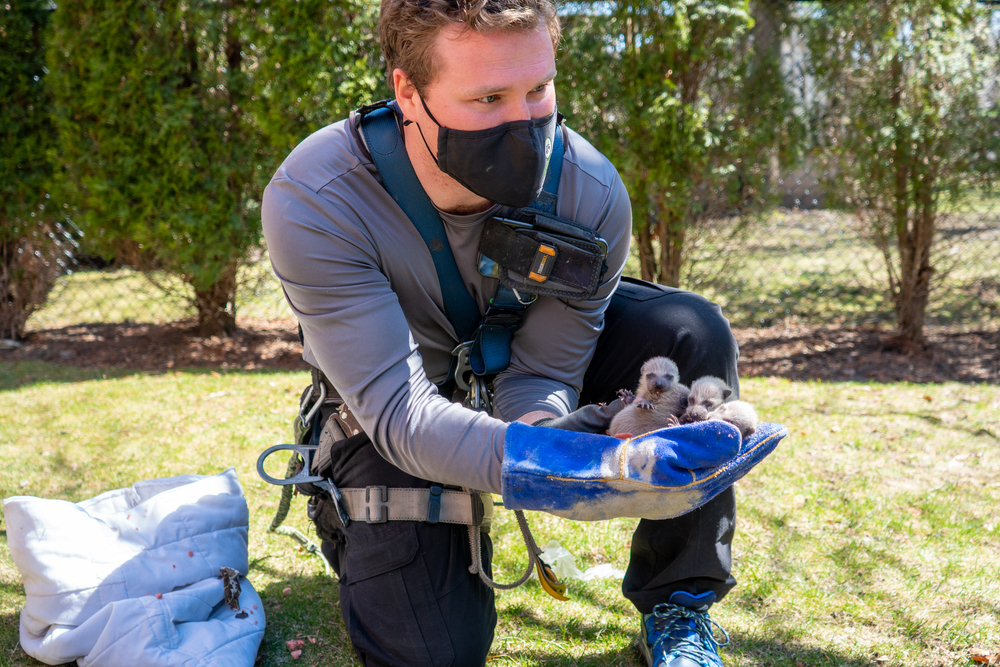Raccoons are sneaky varmints. They are also predictable. Where they sleep is where they nest and nurse their young. Trust a professional to recognize their behaviour patterns and make a plan for safe raccoon removal. They commonly sleep in trees, abandoned cars, barns, and inside your home. creating entry points through natural or artificial openings. Read more about where they sleep and what to do about it.
Trees
Raccoons like trees because they are up high, which equals safety. It also allows them to distantly observe potential threats and make a plan for avoiding would-be predators. Humans, of course, like trees as well, for privacy, beauty, and shade.
Unfortunately, having trees near your home allows raccoons easy access to your garbage bins and leftover food scraps. They can quickly scurry down the tree trunk, rummage through your trash, take what they want, and be back up in the tree before they’re noticed. Experienced professionals who know about wildlife control in Niagara can put a stop to this pesky behaviour.
Abandoned Cars
Another problem arises when vehicles are left abandoned near your home. An orphaned car in the neighbourhood allows raccoons a safe and warm hiding spot. Abandoned cars may also have leftover food wrappers and other victuals that attract the raccoons, or paper and upholstery for easy bedding.
Consider discussing with your neighbours whether they recognize the vehicle. Call your local law enforcement to remove the unclaimed vehicle. If that fails, rely upon our services to identify how the raccoons are entering your property, and explore how to create a barrier that will keep the rascals off of your lawn.
Barns and Toolsheds
Country living has its advantages, yet rodents tend to hide in barns and sheds. Of the three major animal needs (food, water, and shelter), protection from the elements is ready-made with a sturdy barn and dry straw. Some barns even have food and water inside. Barns are also commonly found in proximity to chickens, which raccoons love to capture and eat.
Seal your barn doors at night, especially the loft openings. Raccoons want to stay up off the ground where other predators cannot reach them. Also, make sure that your chicken coops are wired shut. Any device which makes it difficult for the raccoon to gain entry will delay their momentum and cause them to look for an easier target.
Inside Your Home
Worst of all is when raccoons sneak their way into your home. They don’t want you to notice them (they are scared of you!), but once they’re comfortable, they’ll want to stay. They especially love attics, crawlspaces, and hollow chimneys. They want to stay where it is warm and dry, and where they may be able to routinely get a free meal.
Evidence of raccoon presence includes their droppings, a scratching sound in your ceiling at night, damaged insulation, or footprints outdoors. They often enter through soffits, gutters, unsealed chimneys, and openings in siding or brick. Keep any garbage sealed tightly and clean up your grounds regularly.
Call Us Today for Humane Raccoon Removal
Never try to touch or remove a raccoon yourself! They are carriers of rabies, and attempting to confront them may risk your own safety. Call Skedaddle. We know about their gestation periods, their habits, what will lure them out, and how to keep their babies safe while removing the adults. Mothers and babies are then reunited at a location far away from your home.
We will clean any debris and droppings left behind by the animals, and permanently seal their entry points so they don’t come back. Visit our contact us page so our technicians can begin assessing your needs.




